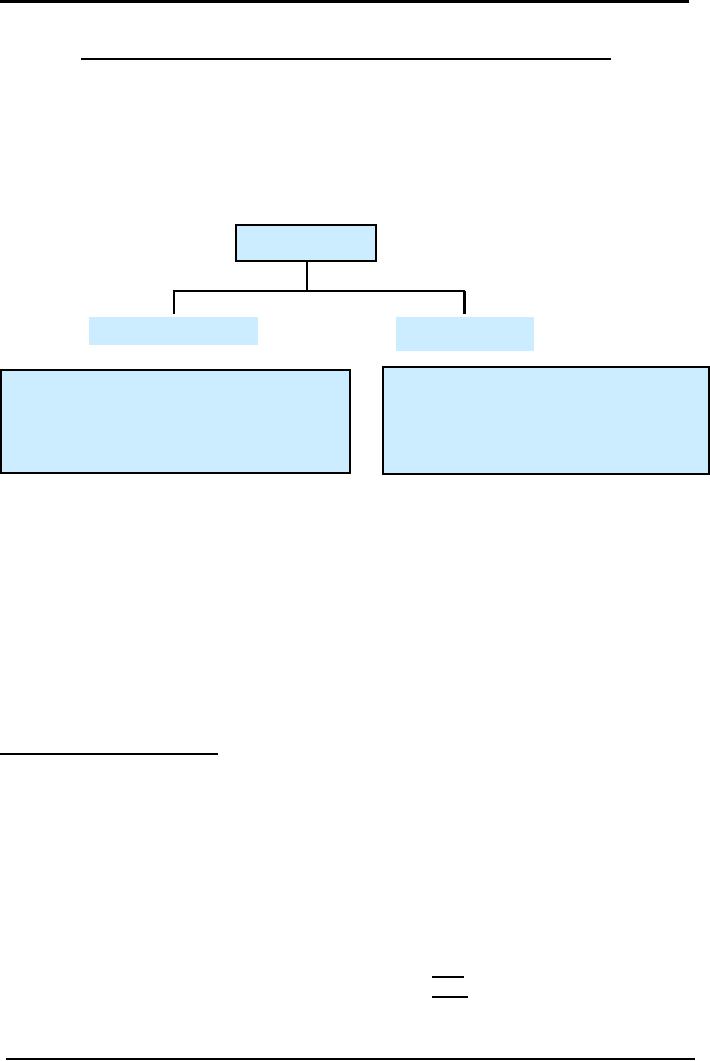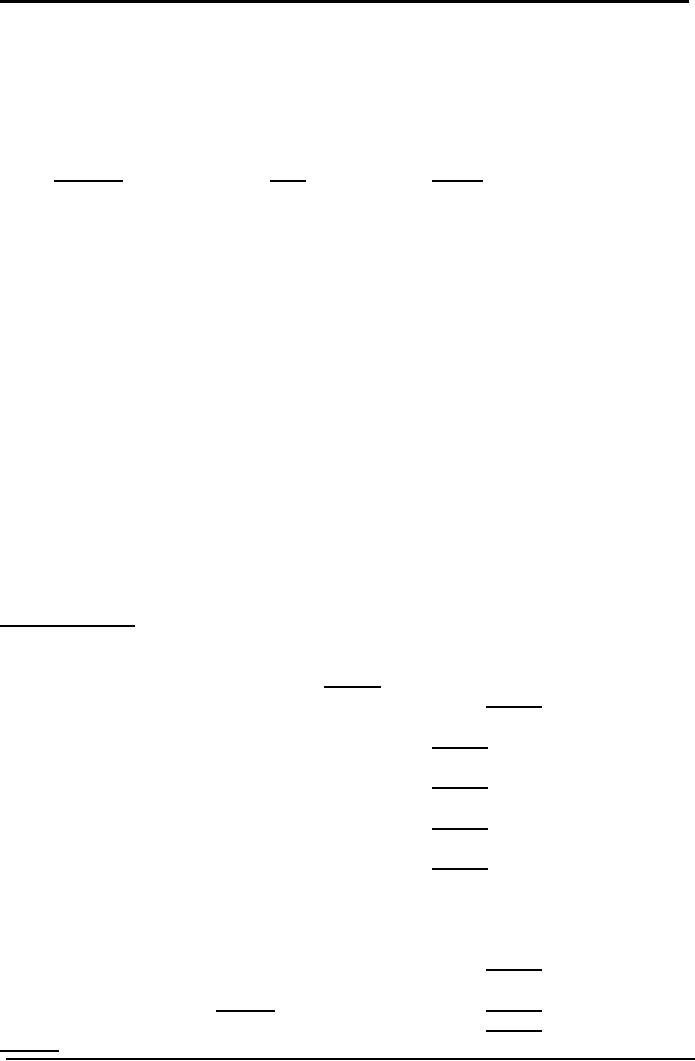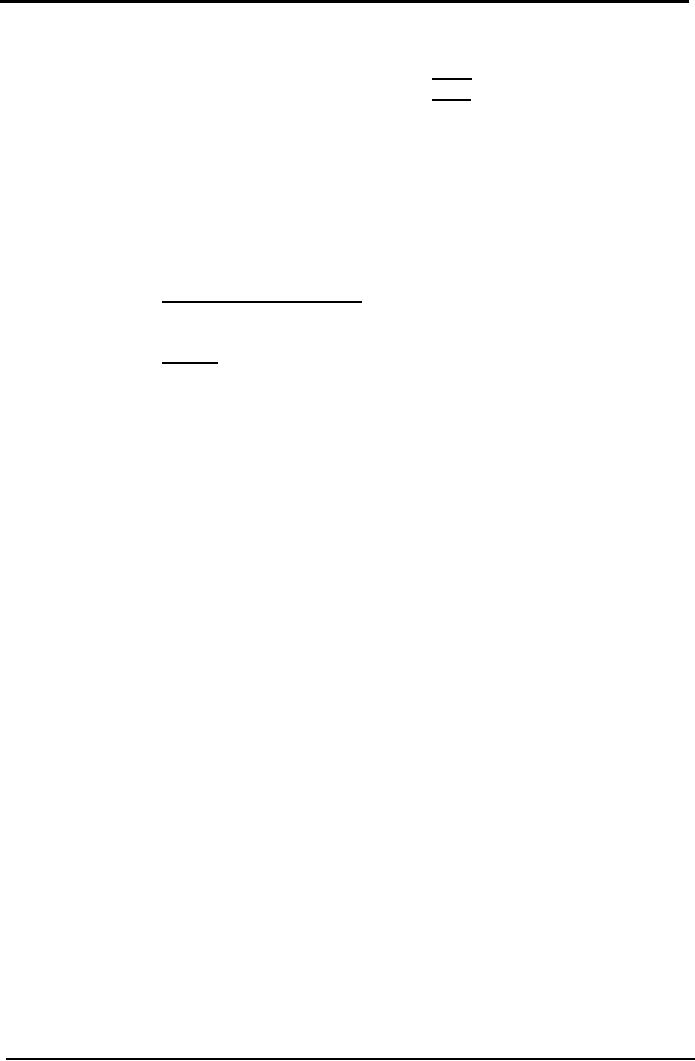 |

Cost
& Management Accounting
(MGT-402)
VU
LESSON#
6
MORE
ABOUT PREPARATION OF FINANCIAL
STATEMENTS
Conversion
Cost
Most
of the times during solving
the problems direct labor cot
and factory overhead costs
are not
given,
instead an amount named as
conversion cost appears in
the question. Conversion cost
is
combination
of these two costs i.e.
Conversion Cost = Direct
labor + Factory overhead
cost.
These
are the two costs
which converts the raw
material into the finished
goods therefore these
are
named
as conversion cost.
Production
Cost
Direct
Material Cost
Conversion
cost
It
consists of both direct
labor cost
It
represents heavy proportion in
product
and
FOH cost. It is used to
convert
cost.
The management should
be
the
direct material cost into
finished
vigilant
about the control of
material cost.
goods.
Valuation
of Closing Finish Goods
inventory
Another
problem that students often
face while solving questions
of cost of goods sold is
non
availability
of cost of finished goods
inventory.
Cost
of finished goods inventory is
calculated by multiplying units of
finished goods
inventory
with
the cost per unit. So to
calculate cost of closing finished
goods inventory following
formula is
used:
Closing
finished goods units x cost
per unit
Some
times cost per unit is
not given in the question, the question
becomes more complex. In
this
situation
some information will be given
that can be used to find
out the cost per
unit.
Cost
per unit is calculated
through the following
formula:
Cost
of goods manufactured = cost
per unit
Number
of units manufactured
This
is also known as per unit
manufacturing cost. There
are two components to this
formula
which
need to be determined before its application.
1.
Cost of goods
manufactured
2.
Number of units
manufactured
Cost
of goods manufactured is calculated in
the way as we have already
discussed. Where as
number
of units manufactured will be obtained
through the following
working:
Units
sold
****
Add
Units closing finished goods
inventory
****
Less
Units opening finished goods
inventory
****
Units
manufactured
****
This
can also be understood
through the following
algebraic manner:
36

Cost
& Management Accounting
(MGT-402)
VU
Opening
finished goods units + Units
produced
Closing finished goods units = Units
sold
Units
produced =
Units sold + Closing finished goods
units - Opening finished goods
units
PRACTICE
QUESTIONS
Q.
1
The
information relating to cost department
of BETA Corporation is as
follows
Inventory
Jan
1
Dec
31
Material
34,000
49,000
Work
in process
82,000
42,000
Finish
goods
48,000
?
Finish
goods inventory
Jan
1
300
units
Dec
31
420
units
Sold
during the year
3,380
units at Rs. 220 per
unit.
Rupees
Material
Purchased
360,000
Conversion
cost
214,400
Freight
In
8,600
Purchase
discount
8,000
Opening
material inventory
34,000
Closing
material inventory
49,000
Prepare
Cost of Goods Sold Statement
from the above
information
Solution
Rupees
Direct
material opening inventory
34,000
Add
Net purchases
Material
Purchased
360,000
Add
Freight Inward
8,600
Less
Purchase discount
8,000
360,600
Material
available for use
394,600
Less
raw material closing stock
49,000
Direct
Material consumed
345,600
Add
Conversion cost
214,400
Total
factory cost
560,000
Add
Opening Work in process
inventory
82,000
Cost
of goods to be manufactured
642,000
Less
Closing Work in process
42,000
Cost
of goods manufactured
600,000
Cost
of Goods Sold
Cost
of goods manufactured
600,000
Add
Opening finished goods
inventory
48,000
Cost
of goods to be sold
648,000
Less
Closing finish goods
(working)
63,000
Cost
of goods sold
585,000
(working)
37

Cost
& Management Accounting
(MGT-402)
VU
Units
sold
3,880
Add
Units
closing finished goods
inventory
300
Less
Units
opening finished goods
inventory
420
Units
manufactured
4,000
This
can also be understood
through the following
algebraic manner:
Opening
finished goods units + Units
produced
Closing finished goods units =
Units sold
300
+ X 420 = 3880
Units
produced =
Units sold + Closing finished goods
units - Opening finished goods
units
X
=
3,880 + 420 300 =
4,000
Cost
per unit
=
Cost
of goods manufactured
Number
of units manufactured
=
600,000
4,000
=
150
Value
of Closing Finish Goods
Inventory
Closing
finish goods = Closing finish
goods units X
Cost
Per unit
=
420 x 150
=
63,000
ASSIGNMENT
QUESTIONS
Q.
1
Following
is the information pertaining to
the production cost of
Revolving Chair Company
for
the
year ending on March 31
2006;
Direct
material consumed
440,000
Direct
labor
290,000
Indirect
labor
46,000
Light
and power
4,260
Depreciation
4,700
Repairs
to machinery
5,800
Other
factory expenses
29,000
Work
in process inventory; April 1,
2005
41,200
Finished
goods inventory; April 1,
2005
34,300
Work
in process inventory; March
31, 2006
42,500
Finished
goods inventory; March 31,
2006
31,500
During
the year 18,000 units
were completed.
Factory
overhead cost is applied @
30% of the direct labor
cost.
Required:
1.
Cost of goods manufactured
statement
2.
Cost of goods sold statement identifying
at normal and at
actual
3.
Cost per unit
4.
Amount of over or under
applied factory overhead
cost
38

Cost
& Management Accounting
(MGT-402)
VU
Q.
2
Records
of Younas Fans show the
following information for
the first quarter of the
year 2006:
Direct
material purchased
1,946,700
Direct
labor
2,125,800
Factory
overhead (40% variable and
60% fixed)
764,000
Marketing
expenses (80% fixed)
516,000
Administrative
expense (100% fixed)
461,000
Sales
(12,400 Fans)
6,634,000
Inventory
opening
Finished
goods (100 fans)
43,000
Direct
material
268,000
Inventory
closing
Finished
goods (200 fans)
not
known
Direct
material
167,000
There
was no opening and closing work in
process inventory.
Required:
1.
Number
of units manufactured during
the quarter
2.
Cost
of goods manufactured statement for
the quarter
3.
Value
of closing finished goods
inventory
4.
Income
statement for the
quarter
5.
Gross
profit per unit
6.
Net
profit per unit
7.
Gross
profit to sales ratio
8.
Cost
of goods sold to sales
ratio
9.
Fixed
production cost per
unit
10.
Variable
production cost per
unit
11.
Fixed
expenses per unit
sold
12.
Variable
expenses per unit
sold
39
Table of Contents:
- COST CLASSIFICATION AND COST BEHAVIOR INTRODUCTION:COST CLASSIFICATION,
- IMPORTANT TERMINOLOGIES:Cost Center, Profit Centre, Differential Cost or Incremental cost
- FINANCIAL STATEMENTS:Inventory, Direct Material Consumed, Total Factory Cost
- FINANCIAL STATEMENTS:Adjustment in the Entire Production, Adjustment in the Income Statement
- PROBLEMS IN PREPARATION OF FINANCIAL STATEMENTS:Gross Profit Margin Rate, Net Profit Ratio
- MORE ABOUT PREPARATION OF FINANCIAL STATEMENTS:Conversion Cost
- MATERIAL:Inventory, Perpetual Inventory System, Weighted Average Method (W.Avg)
- CONTROL OVER MATERIAL:Order Level, Maximum Stock Level, Danger Level
- ECONOMIC ORDERING QUANTITY:EOQ Graph, PROBLEMS
- ACCOUNTING FOR LOSSES:Spoiled output, Accounting treatment, Inventory Turnover Ratio
- LABOR:Direct Labor Cost, Mechanical Methods, MAKING PAYMENTS TO EMPLOYEES
- PAYROLL AND INCENTIVES:Systems of Wages, Premium Plans
- PIECE RATE BASE PREMIUM PLANS:Suitability of Piece Rate System, GROUP BONUS SYSTEMS
- LABOR TURNOVER AND LABOR EFFICIENCY RATIOS & FACTORY OVERHEAD COST
- ALLOCATION AND APPORTIONMENT OF FOH COST
- FACTORY OVERHEAD COST:Marketing, Research and development
- FACTORY OVERHEAD COST:Spending Variance, Capacity/Volume Variance
- JOB ORDER COSTING SYSTEM:Direct Materials, Direct Labor, Factory Overhead
- PROCESS COSTING SYSTEM:Data Collection, Cost of Completed Output
- PROCESS COSTING SYSTEM:Cost of Production Report, Quantity Schedule
- PROCESS COSTING SYSTEM:Normal Loss at the End of Process
- PROCESS COSTING SYSTEM:PRACTICE QUESTION
- PROCESS COSTING SYSTEM:Partially-processed units, Equivalent units
- PROCESS COSTING SYSTEM:Weighted average method, Cost of Production Report
- COSTING/VALUATION OF JOINT AND BY PRODUCTS:Accounting for joint products
- COSTING/VALUATION OF JOINT AND BY PRODUCTS:Problems of common costs
- MARGINAL AND ABSORPTION COSTING:Contribution Margin, Marginal cost per unit
- MARGINAL AND ABSORPTION COSTING:Contribution and profit
- COST – VOLUME – PROFIT ANALYSIS:Contribution Margin Approach & CVP Analysis
- COST – VOLUME – PROFIT ANALYSIS:Target Contribution Margin
- BREAK EVEN ANALYSIS – MARGIN OF SAFETY:Margin of Safety (MOS), Using Budget profit
- BREAKEVEN ANALYSIS – CHARTS AND GRAPHS:Usefulness of charts
- WHAT IS A BUDGET?:Budgetary control, Making a Forecast, Preparing budgets
- Production & Sales Budget:Rolling budget, Sales budget
- Production & Sales Budget:Illustration 1, Production budget
- FLEXIBLE BUDGET:Capacity and volume, Theoretical Capacity
- FLEXIBLE BUDGET:ANALYSIS OF COST BEHAVIOR, Fixed Expenses
- TYPES OF BUDGET:Format of Cash Budget,
- Complex Cash Budget & Flexible Budget:Comparing actual with original budget
- FLEXIBLE & ZERO BASE BUDGETING:Efficiency Ratio, Performance budgeting
- DECISION MAKING IN MANAGEMENT ACCOUNTING:Spare capacity costs, Sunk cost
- DECISION MAKING:Size of fund, Income statement
- DECISION MAKING:Avoidable Costs, Non-Relevant Variable Costs, Absorbed Overhead
- DECISION MAKING CHOICE OF PRODUCT (PRODUCT MIX) DECISIONS
- DECISION MAKING CHOICE OF PRODUCT (PRODUCT MIX) DECISIONS:MAKE OR BUY DECISIONS